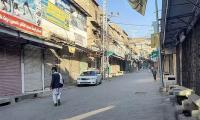Every economy undergoes various ups and downs and business cycles caused by many internal and external factors affecting businesses in general and some in particular.
Pakistan in its history of 71 years has seen many such upheavals starting with Korean War and subsequent devaluation. There was another major shock resulting of dismemberment of Pakistan in 1971 affecting the businesses owned by West Pakistan Businessmen and those from West Pakistan for whom East Pakistan was a captive market.
Immediately thereafter in December 1971, there was Nationalization of ten basic Industries including shipping, heavy chemicals, iron and steel, oil refineries, heavy engineering, heavy electrical, petrochemicals, cement and electric utilities. Again on January 1974, government announced nationalization of Banks and Insurance companies. Once again on July 1, 1976 government announced the nationalization of cotton ginning, rice husking and flourmills. Besides the foregoing the reforms in health sector introduced generic formula system abolishing branded drugs production, nationalization of schools and colleges including higher education engineering colleges e.g., Dawood College for Engineering, Karachi.
This period also witnessed abolishing the multiple exchange rate system, which provided for varying rates of Bonus Vouchers freely tradable at the stock markets for the importers to meet their requirements and from official rate of exchange of Rs.4.75 per US Dollar to Rs.11.00 per US Dollar. The above brought about a sea change in overall business climate and morale and almost ruined many businesses and businessmen without any recourse.
After change of regime and imposition of Martial law in 1977, the atmosphere saw a change in different way and government became more interactive with businessmen.
In circa 1980, there was a major cotton crop failure. As per my vague memory, the normal cotton crop, which used to produce about 4 million bales of cotton it dropped to 2.2 million bales. Economist say that if there is a 5% over supply of a commodity the prices crash, similarly if there were 5% short supply, the prices sky rocket what to talk of 45% drop in cotton output. The cotton prices saw a meteoric rise. Textile Industry, which was 70% of the country’s industry, went into a tailspin. The industry was still struggling with the negative effects of devaluation, which had booked their foreign currency liabilities at Rs.4.75 per Dollar or equivalent in the other currencies had to revise their bank liabilities. A few survived and government came to the rescue in a half-hearted manner and set up a committee under the stewardship of then Secretary Ministry of Finance, Mr. H. U. Beg, famously known as the beg Committee. In the final report as far as my memory goes the help were to be given only to those industries, which were willing for a management change.
Following the above stated cotton crisis, the background of various packages and reliefs for delinquent loan accounts provided by Federal Government directly or through SBP.
(The writer is former Chairman, Export Promotion Bureau, Government of Pakistan. wajidjawad@yahoo.com)
To be continued
Sohail Anwar Sial says they have CCTV footage in which Abbasi's son and his friends are seen firing at his house
It is noteworthy that current bilateral trade volume between Pakistan and UAE stands at approximately $8 billion







